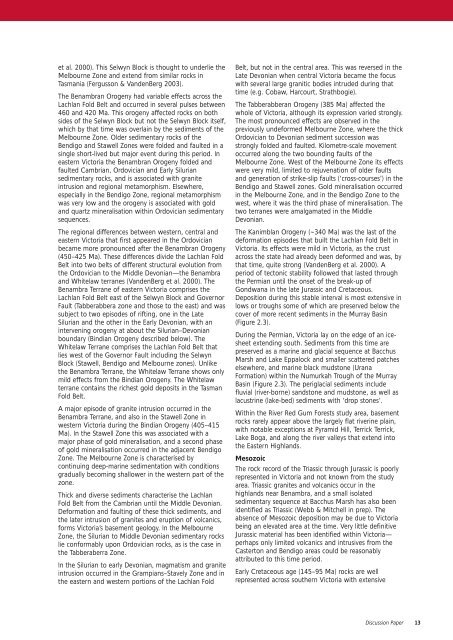Discussion Paper - Part A - Victorian Environmental Assessment ...
Discussion Paper - Part A - Victorian Environmental Assessment ...
Discussion Paper - Part A - Victorian Environmental Assessment ...
- No tags were found...
You also want an ePaper? Increase the reach of your titles
YUMPU automatically turns print PDFs into web optimized ePapers that Google loves.
et al. 2000). This Selwyn Block is thought to underlie theMelbourne Zone and extend from similar rocks inTasmania (Fergusson & VandenBerg 2003).The Benambran Orogeny had variable effects across theLachlan Fold Belt and occurred in several pulses between460 and 420 Ma. This orogeny affected rocks on bothsides of the Selwyn Block but not the Selwyn Block itself,which by that time was overlain by the sediments of theMelbourne Zone. Older sedimentary rocks of theBendigo and Stawell Zones were folded and faulted in asingle short-lived but major event during this period. Ineastern Victoria the Benambran Orogeny folded andfaulted Cambrian, Ordovician and Early Siluriansedimentary rocks, and is associated with graniteintrusion and regional metamorphism. Elsewhere,especially in the Bendigo Zone, regional metamorphismwas very low and the orogeny is associated with goldand quartz mineralisation within Ordovician sedimentarysequences.The regional differences between western, central andeastern Victoria that first appeared in the Ordovicianbecame more pronounced after the Benambran Orogeny(450–425 Ma). These differences divide the Lachlan FoldBelt into two belts of different structural evolution fromthe Ordovician to the Middle Devonian—the Benambraand Whitelaw terranes (VandenBerg et al. 2000). TheBenambra Terrane of eastern Victoria comprises theLachlan Fold Belt east of the Selwyn Block and GovernorFault (Tabberabbera zone and those to the east) and wassubject to two episodes of rifting, one in the LateSilurian and the other in the Early Devonian, with anintervening orogeny at about the Silurian–Devonianboundary (Bindian Orogeny described below). TheWhitelaw Terrane comprises the Lachlan Fold Belt thatlies west of the Governor Fault including the SelwynBlock (Stawell, Bendigo and Melbourne zones). Unlikethe Benambra Terrane, the Whitelaw Terrane shows onlymild effects from the Bindian Orogeny. The Whitelawterrane contains the richest gold deposits in the TasmanFold Belt.A major episode of granite intrusion occurred in theBenambra Terrane, and also in the Stawell Zone inwestern Victoria during the Bindian Orogeny (405–415Ma). In the Stawell Zone this was associated with amajor phase of gold mineralisation, and a second phaseof gold mineralisation occurred in the adjacent BendigoZone. The Melbourne Zone is characterised bycontinuing deep-marine sedimentation with conditionsgradually becoming shallower in the western part of thezone.Thick and diverse sediments characterise the LachlanFold Belt from the Cambrian until the Middle Devonian.Deformation and faulting of these thick sediments, andthe later intrusion of granites and eruption of volcanics,forms Victoria’s basement geology. In the MelbourneZone, the Silurian to Middle Devonian sedimentary rockslie conformably upon Ordovician rocks, as is the case inthe Tabberaberra Zone.In the Silurian to early Devonian, magmatism and graniteintrusion occurred in the Grampians–Stavely Zone and inthe eastern and western portions of the Lachlan FoldBelt, but not in the central area. This was reversed in theLate Devonian when central Victoria became the focuswith several large granitic bodies intruded during thattime (e.g. Cobaw, Harcourt, Strathbogie).The Tabberabberan Orogeny (385 Ma) affected thewhole of Victoria, although its expression varied strongly.The most pronounced effects are observed in thepreviously undeformed Melbourne Zone, where the thickOrdovician to Devonian sediment succession wasstrongly folded and faulted. Kilometre-scale movementoccurred along the two bounding faults of theMelbourne Zone. West of the Melbourne Zone its effectswere very mild, limited to rejuvenation of older faultsand generation of strike-slip faults (‘cross-courses’) in theBendigo and Stawell zones. Gold mineralisation occurredin the Melbourne Zone, and in the Bendigo Zone to thewest, where it was the third phase of mineralisation. Thetwo terranes were amalgamated in the MiddleDevonian.The Kanimblan Orogeny (~340 Ma) was the last of thedeformation episodes that built the Lachlan Fold Belt inVictoria. Its effects were mild in Victoria, as the crustacross the state had already been deformed and was, bythat time, quite strong (VandenBerg et al. 2000). Aperiod of tectonic stability followed that lasted throughthe Permian until the onset of the break-up ofGondwana in the late Jurassic and Cretaceous.Deposition during this stable interval is most extensive inlows or troughs some of which are preserved below thecover of more recent sediments in the Murray Basin(Figure 2.3).During the Permian, Victoria lay on the edge of an icesheetextending south. Sediments from this time arepreserved as a marine and glacial sequence at BacchusMarsh and Lake Eppalock and smaller scattered patcheselsewhere, and marine black mudstone (UranaFormation) within the Numurkah Trough of the MurrayBasin (Figure 2.3). The periglacial sediments includefluvial (river-borne) sandstone and mudstone, as well aslacustrine (lake-bed) sediments with ‘drop stones’.Within the River Red Gum Forests study area, basementrocks rarely appear above the largely flat riverine plain,with notable exceptions at Pyramid Hill, Terrick Terrick,Lake Boga, and along the river valleys that extend intothe Eastern Highlands.MesozoicThe rock record of the Triassic through Jurassic is poorlyrepresented in Victoria and not known from the studyarea. Triassic granites and volcanics occur in thehighlands near Benambra, and a small isolatedsedimentary sequence at Bacchus Marsh has also beenidentified as Triassic (Webb & Mitchell in prep). Theabsence of Mesozoic deposition may be due to Victoriabeing an elevated area at the time. Very little definitiveJurassic material has been identified within Victoria—perhaps only limited volcanics and intrusives from theCasterton and Bendigo areas could be reasonablyattributed to this time period.Early Cretaceous age (145–95 Ma) rocks are wellrepresented across southern Victoria with extensive<strong>Discussion</strong> <strong>Paper</strong>13
















